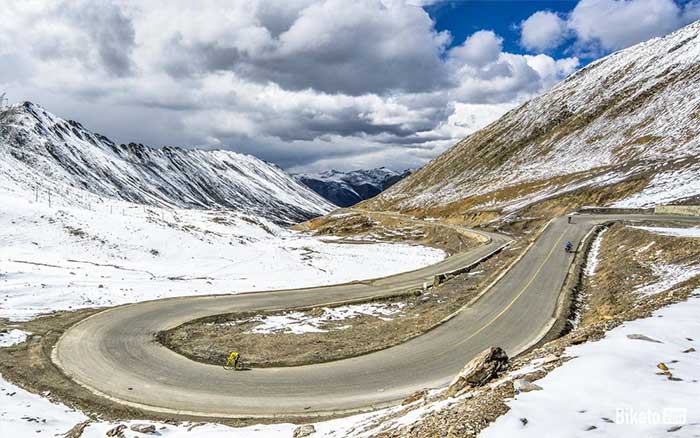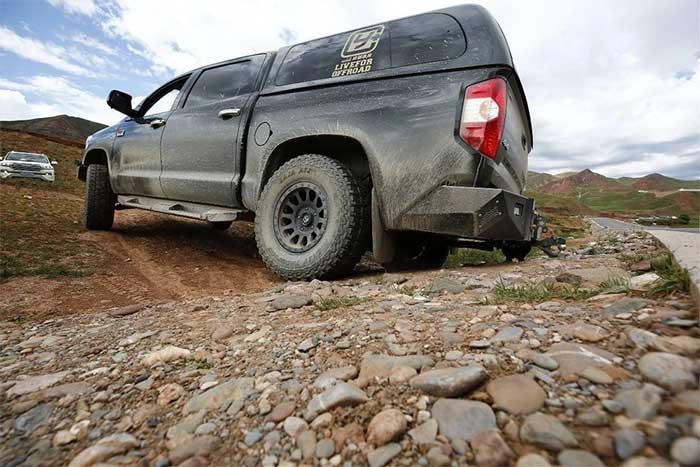Although the value of abandoned vehicles is considerable, the risk of retrieving them is even greater.
A Road That Challenges Every Driver
The Tibet Autonomous Region in southwestern China presents a true test for seasoned drivers, featuring dozens of dramatic hairpin turns at altitudes of several thousand meters.
The most impressive of these is the road known as “72 Hairpin Turns of the Nujiang River”, which runs along the Sichuan-Tibet Highway. This winding road stretches for 30 kilometers, ascending from an altitude of 1,800 meters to a breathtaking 4,658 meters.
From these turns, travelers can admire the serpentine road winding through a backdrop of snow-capped mountains.
The Sichuan-Tibet route is one of the most dangerous roads, situated at the highest altitudes. Therefore, driving on this road is not a simple task. Especially at elevations of several thousand meters above sea level, as one drives higher, the phenomenon of “altitude sickness” becomes more likely. Altitude sickness can escalate into pulmonary or cerebral edema.
The majestic and stunning scenery of nature is the reward for those who dare to challenge themselves.

Sichuan-Tibet Road. (Image: Sohu).
The Land of “One-Way Vehicles”
However, what piques curiosity about this road is the numerous vehicles abandoned along the way. According to Sohu, there are at least 300 abandoned vehicles on the Sichuan-Tibet route, including sedans, SUVs, off-road vehicles, and even luxury cars.
In reality, these vehicles once had owners. The primary reason they were abandoned here is due to landslides or severe weather conditions that rendered the vehicles inoperable.
The Sichuan-Tibet route is famous for being thrilling yet perilous. Everyone is eager to set off, but halfway through, many begin to hesitate. Some even turn back before reaching the halfway point, with others abandoning their vehicles altogether and walking back.

Many luxury car owners have sadly left their vehicles behind. (Image: Sohu).
The reason is quite simple: the vehicles break down, and the road is extremely difficult to navigate. On other roads, if a vehicle breaks down, one can simply ask locals for help or call an emergency rescue team. But on the Sichuan-Tibet route, a breakdown is a significant problem.
There are virtually no repair shops here, or they are too far away. When help is finally found, by the time they return, the vehicle may have lost parts to thieves or suffered damage from animals.
A Pile of Assets Left Untouched
The question arises: why don’t locals take these ownerless vehicles home to repair and use or sell them? In fact, the locals have three reasons to explain this.
First, the cost of towing a broken-down vehicle here is exorbitant. If the cost were similar to other places, the owners would not have to abandon their vehicles.
The Sichuan-Tibet route is essentially uninhabited territory, with stretches of dozens of kilometers devoid of any human presence. If a vehicle breaks down, it is likely due to severe weather or geological disasters. Due to the unique terrain, rescue vehicles find it challenging to access. Even if they do manage to reach the area, they can only transport people to safety; repairing the vehicle or storing it on-site is difficult.
Furthermore, if a rescue team can reach the vehicle, it may end up in worse condition than when it was found. Some believe that the vehicles, once brought home, would only be worth scrap metal, and selling them wouldn’t cover the costs incurred.

Vehicles gradually deteriorate over time. (Image: Sohu).
Second, the abandoned vehicles are often severely damaged. Repair costs can exceed the actual value of the vehicle.
In practice, the reasons for vehicle breakdowns may include flat tires, skidding, engine failure, and other issues. However, if a vehicle breaks down in poor weather, it could be damaged by hail or fall into a ravine during a landslide.
Aside from the frame, these vehicles are essentially scrap. They hold no value for recycling. Moreover, the owner still has to pay towing and storage fees.
At this point, vehicle owners typically resort to insurance, treating the vehicle as scrap, and ownership will transfer to the insurance company. After weighing the pros and cons, the insurance company often overlooks these abandoned vehicles.
Third, there’s a high risk of legal issues. Just because an owner has abandoned their vehicle doesn’t mean they won’t return.
Taking these abandoned vehicles could constitute theft. The ownership of these vehicles may belong to either the insurance company or the original owner. Anyone taking a vehicle not only faces significant transport costs but also legal risks.
As a result, locals remain indifferent when encountering these vehicles. There’s even a local saying: Don’t be tempted by these vehicles, as you may soon regret it.




















































